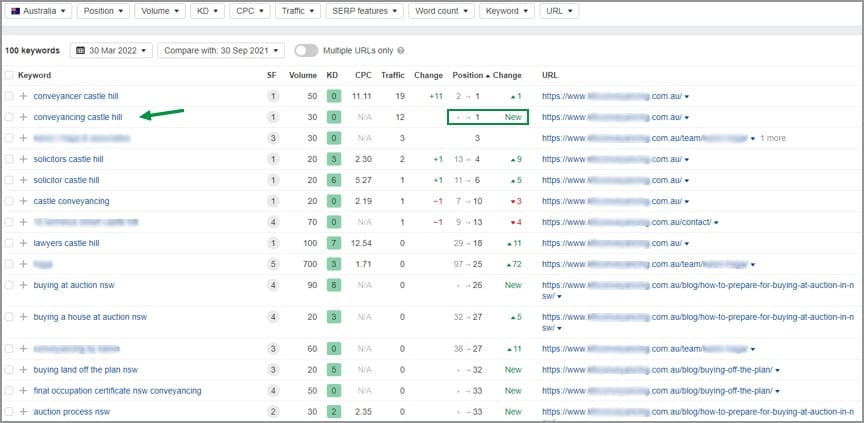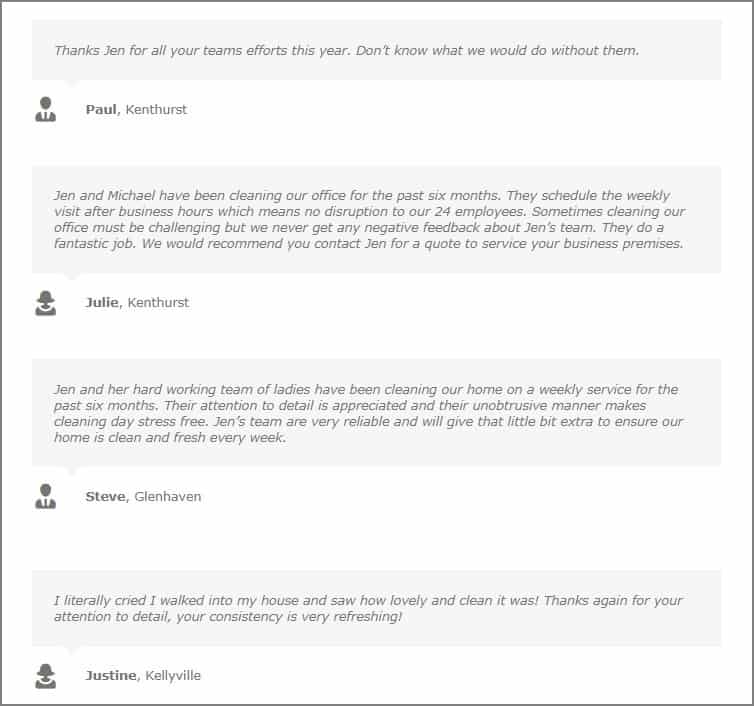Does blogging help local SEO? A lot of smaller businesses aren’t sure. They worry that blogging will get them traffic from out-of-area – people who will never convert to actual customers. They can’t see the point in spending time and effort to build a blog.
In fact, a well-optimised blog, updated as part of a well-optimised site, will do wonders in bringing in local traffic. And that traffic won’t just be people visiting the blog pages. Your blog helps the other pages on your site too.
Here’s a real-life example of a blog helping local SEO
We write and publish blogs for a firm of conveyancers in Castle Hill, in northwestern Sydney. Their clients are – unsurprisingly – local. They didn’t have a blog before we started, and we only publish one post a month. With a break for Christmas and summer, we’ve published less than a dozen posts.
This report shows what’s happened to their SEO.

This is just a snapshot of their best results – where a web page from their site appears on page one, two or three of Google. For each keyword, you can see the current position in search results, plus the change from 6 months previously.
- Their search ranking has improved for 12 out of 15 of these keywords.
- 5 of those improved rankings are actually new keywords. They weren’t even in the top ten pages, and now they’re on the first three pages. With the opportunity to rise even higher as we publish more.
But the best result of all is that the home page is the number one result when people search for ‘conveyancing castle hill’.
‘conveyancing castle hill‘ is what we call a ‘buying intent’ keyword. People who search for this are actively looking for a conveyancer, right now. It’s a spectacular result.
- We didn’t target this keyword.
- Our client didn’t show up at all for it 6 months ago.
- Now they’re the number one result.
Notice that it’s the home page which appears in search, not a blog post. But the home page hasn’t changed at all in this time. The only thing which has changed on the client website is that we’ve added blog posts.
How does blogging help local SEO in this way?
There are two main factors at play here:
1. The blog lifts the entire site
If your site has a blog and you update that regularly, two key things happen:
- Google knows that the content is fresh and the site is maintained. That has a positive effect on rankings for every single page on the site.
- You also have a range of interesting articles on your site. Other people will link to them. (Be realistic – if you only have sales pages for your products and services, who’s going to link to those?) In Google’s view, every single link from another site is a vote of confidence in your site. Once again, rankings for your entire site improve.
Note that it’s not just quantity of links, it’s the quality of them too. If you can get a link from a ‘high authority’ site (the ABC, or Wikipedia, or an official government department), that’s the best of all. That means a major player is endorsing you.
The blog doesn’t just help itself. It helps each and every page on your site. That includes the hero pages which you want people to visit – your home page and your service pages.

2. The main site is well optimised already
Thanks to a good web developer who was onboard already, the main site was well optimised for local SEO.
- Google knows that the site is about conveyancing and buying and selling real estate
- Google knows that the business is in Castle Hill and serves primarily the Hills district.
The important thing to consider now is that Google wants to provide results which are as useful as possible. The more accurate and helpful the search results, the more people use Google and the more money the company can make from advertisers. So, Google knows that in many cases, people are looking for something near them. And as a result, it prioritises local businesses in search results.
Unless you’re connecting to the internet via a VPN, Google has a pretty idea where you are, and they know which suburbs are near you. So if our client is showing up for ‘conveyancing Castle Hill‘, chances are they’re also showing up when people nearby search for ‘conveyancing near me’.
Key learnings – how you can improve your local SEO
As you can see, there are two things you need to make this work.
A blog. And core pages well optimised for your service and location.
The blog is the easy bit. You can use our blogging service. Or you can write your own blog. Just make sure you create quality content and publish consistently.
But what about your core business pages? What can you do to optimise those?
Some tips to improve local SEO
Never lose site of the goal. With local SEO, your aim is to make sure Google knows
- what you do
- what areas you serve
Here are some ways to work on that:
On your website
- Include your address on your site.
It sounds simple. It is. An added benefit is that humans like it too – it makes you more ‘real’ and trustworthy.
Ideally, put your address in your footer as well as on your contact page. This means it’s on every page of your site. - You can also include a line describing the areas you service. A list of suburbs, or a regional description like ‘the Hills District’ works fine.
- Include both key services and your location / area served in your meta title and meta description. (If your web designer / marketing support haven’t set up metadata for you, let us know. On most sites it’s quite simple to add and we can teach you.
- If you want to be really fancy, you can use schema mark-up to describe the area your service on all yiour service or product pages.
- If it’s suitable for your business, publish the suburb in testimonials on your site. Over time, this gives you a whole range of local SEO keywords. Here’s an example from the wonderful Jenni Lawton at Jen’s Cleaning

- If you’re involved with the local community, include information about that and links to any relevant local sites. Publish blog articles talking about local events or teams that you sponsor.
Elsewhere on the web
- Create a Google MyBusiness account. Get some positive reviews. Make a few posts. Make sure you include your address – and make sure you use exactly the same format you use on your website and your Google MyBusiness profile.
- List in business directories. (And use the same address details as on your website.) We’ve compiled a list of Australian business directories you can add your company to.
- There may also be local directories or groups with an online presence where you can add your details.
And really, it’s important to get those address (and business name, and phone) details consistent. I have known businesses who listed in different directories with different suburbs. That’s a bad idea. You don’t get to be top anywhere, and you present to Google as unreliable. My advice – don’t do it!
***







I wish to congratulate the writer for bringing up such an important topic so nicely in this post. Using blog posts to promote your products has many benefits undoubtedly. The potential benefits include extra promotion by using the most recent SEO strategies and tools. Each strategy and tool helps to provide better results. But learning and buying these skills are expensive. It is preferable to outsource SEO work in order to control costs. Agencies also share ownership of this technology and spend less on training.
It really interests me in reading such articles, thanks for sharing. Blogs like yours and info https://oso-link.com/ help me learn more day by day.